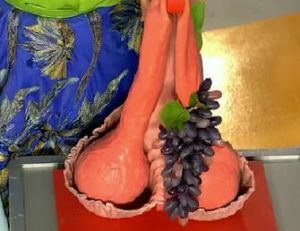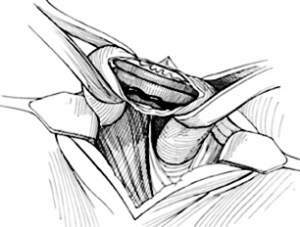 Varicocele is a pathology that occurs only in men, in other words it is varicose veins in the area of the spermatic cord.
Varicocele is a pathology that occurs only in men, in other words it is varicose veins in the area of the spermatic cord.
As a consequence, venous nodes are formed in the scrotum and blood flow is disturbed. The disease has three stages of development, each of which is characterized by certain manifestations.
In the early stages varicocele does not reveal itself in any way and the man most often does not suspect about the disease. Subsequently, when the disease begins to gradually progress, the scrotum develops puffiness and painful sensations, which increase with walking.
The lack of treatment threatens to disrupt the function of the testicles and the activity of spermatozoa, which can lead to infertility.
This disease is successfully treated with the help of surgical intervention. But it happens that the disease occurs repeatedly after surgery, this phenomenon is called a relapse varicocele.
Contents of
- Some statistics
- Causes and symptoms
- Methods of solving the
- problem Possible complications after surgery
- Relapse prevention
Some statistics
With recurrence of the disease, 10 to 40% of the male representatives face, which is manifested in the resumption of the process of pathological changes. The likelihood of such a problem is much higher in adolescent patients.
For this reason, varicocele in adolescents operate only in extreme cases, most often experts advise waiting for the period of puberty.
Relapse is developing slowly, and its signs may appear 12 months or more after surgery. Symptoms of repeated varicocele are similar to its primary manifestations.
Causes and Symptoms of
Reasons for developing relapse may be due to both the individual characteristics of the patient's body, the  and the consequence of surgical intervention.
and the consequence of surgical intervention.
However, recurrence of the disease associated with the genetic predisposition of the patient is rare. In general, the disease returns due to the passage of inflows during the operation, insufficient distribution and action of sclerosing drugs or loose ligation of the vein.
In addition, relapse is associated with the dissolution or movement of a substance that blocked the affected vein. Also in medicine there were cases when, due to insufficient visualization, the intervention was carried out on the vessels in fatty tissue, not related to varicocele, and accordingly, recovery did not occur.
Relapse begins to manifest itself 12-18 months after the operation, and is accompanied by an expansion of veins in the scrotum, pain in walking, sexual intercourse and power loads. In such cases, the operation is performed when the recurrent disease has reached stage 2 or stage 3.
Ways to solve the problem
To date, medicine is coping well with this disease. In order to solve the problem of repeated varicocele, the same methods as in the primary disease, namely surgical intervention, are used. During the operation, the veins that have been injured and the measures for restoring the normal circulatory process are made.
Depending on the patient's condition and the recommendations of the attending physician, the following surgical procedures can be used:
- Surgical intervention by the method of Palomo and Ivanssevich .This kind of surgical treatment is applied quite
 often. However, it is considered insufficiently effective and causes a huge number of complications in the operated patients afterwards.
often. However, it is considered insufficiently effective and causes a huge number of complications in the operated patients afterwards. - The mini-operation method .This method of treatment is used in combination with other therapeutic measures and is considered highly effective. In addition, the area of tissue damage in mini-operations is relatively small, which contributes to the rapid postoperative rehabilitation of the patient. The drawbacks of this technique can be attributed to the fact that the operation takes a long time and the patient is exposed to harmful X-rays.
- Introduction of the shunt .Shunting allows you to block and redirect blood flow, limiting the access of blood to the damaged vein and directing it to healthy vessels. This method is not often used because of low efficiency. In addition, such an intervention often causes subsequent complications in the form of blood clots.
- The method of percutaneous embolization of .This technique is also used quite rarely because of the possible appearance of scars in the area of damage. However, the effectiveness of this type of treatment is quite high.
- Method of laparoscopy .In the process of laparoscopic surgery, a stethoscope is introduced into the abdominal cavity area to examine the affected veins and possible branching. The advantage of laparoscopy is that the rehabilitation period in patients does not take much time and the efficiency percentage is high enough.
- Microsurgical revascularization .In Russia, this method of treatment is not widely used because many clinics do not have the equipment necessary for the operation. However, such intervention is highly effective.
In the course of the operation, a gluing agent is introduced into the affected vein, the action of which allows to restore its operability. Another advantage of microsurgical revascularization can be considered that relapses after this type of intervention occur much less often than with other methods.
During rehabilitation, the patient is prohibited from lifting weights and other physical exertion. In addition, in the first month after surgery, it is better for a man to refrain from having sexual intercourse.
As a rule, varicocele is successfully treated, and in cases where the disease has caused infertility of the patient, with a successful outcome, the viability of spermatozoa is restored.
Possible complications after surgery
In most cases, after surgery, complications do not occur, but in some patients the following manifestations may occur: 
- swelling of one side of the scrotum , which after some time passes by itself - for thatTo prevent puffiness, patients are advised to wear a special supporting suspension in the first postoperative week;
- pain in the scrotum , disappearing after the patient has taken antibacterial and anti-inflammatory drugs;
- fluid retention in the scrotum ( hydrocele), which is observed in almost half of patients in the postoperative period, but most often passes on its own 8-10 months after the intervention;
- occurrence of atrophy or malnutrition of the testes , which occurs extremely rarely after some types of operations.
In addition to the listed common types of complications, there are consequences occurring after a certain type of treatment. For example, the consequence of endovascular intervention may be an allergic reaction to the injected substance, and after laparoscopy bleeding is extremely rare.
Relapse prevention
Regarding why there is a relapse varikotsele, physicians to this day did not come to a consensus. For this reason, it is not possible to talk about the presence of any serious preventive measures that can prevent both the initial disease and its relapse.
In cases when varicocele is associated with genetic disorders in the body of the patient, the consequences can be unpredictable and relapse is quite possible.
But in most cases it is possible to prevent a recurrent disease by conducting a thorough examination of the patient before the operation. This will reduce the risk of leaving the affected vessel unblocked, which can lead to a relapse.
During the postoperative period, the patient should follow all the prescriptions of the doctor, avoid heavy physical exertion and give up smoking and alcohol. In addition, it is necessary to visit the doctor on a regular basis and immediately seek medical help at the first signs of the disease.
